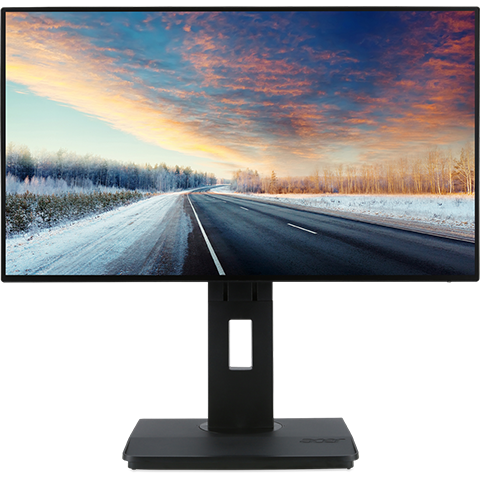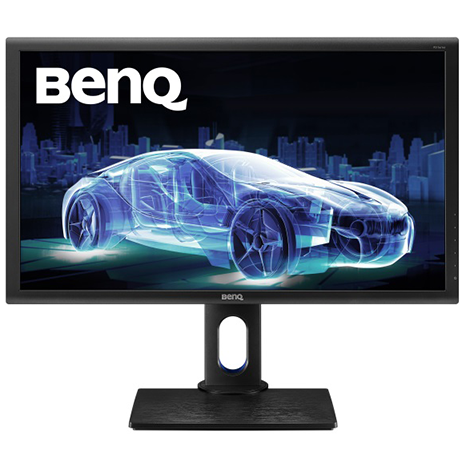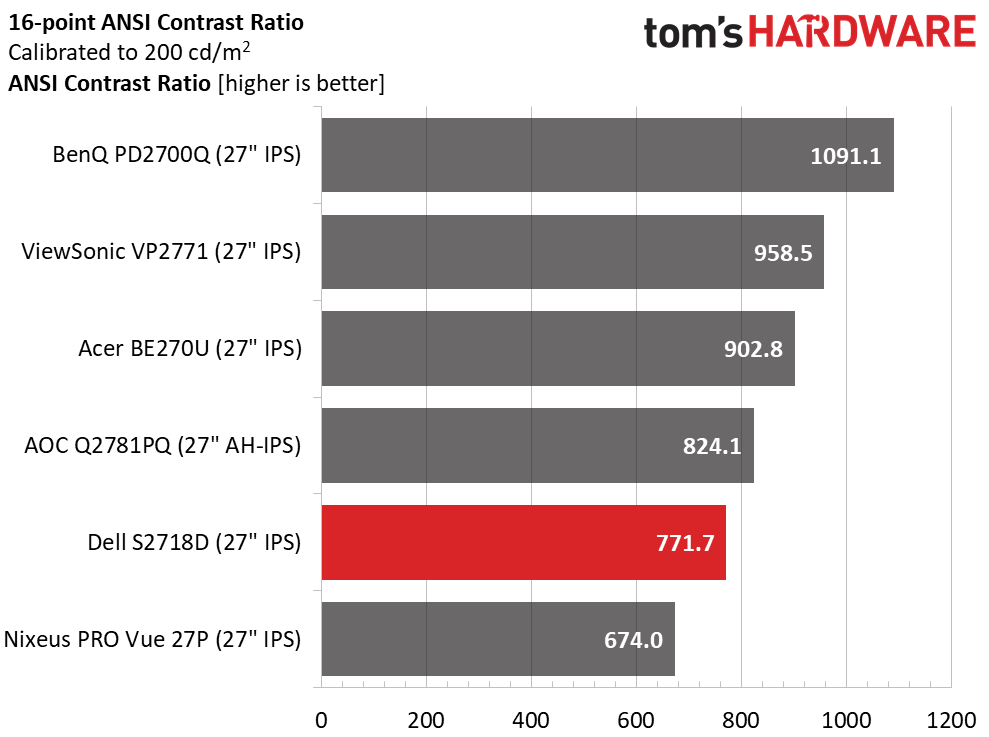Dell S2718D HDR Monitor Review
Why you can trust Tom's Hardware
Brightness & Contrast
To read about our monitor tests in depth, please check out Display Testing Explained: How We Test Monitors and TVs. Brightness and Contrast testing is covered on page two.
Uncalibrated – Maximum Backlight Level
We don’t have any other HDR-compatible monitors in our database, so we’ve included premium IPS/QHD screens for today’s comparison. All offer similar performance with SDR material. We have ViewSonic’s VP2771, Acer’s BE270U, BenQ’s PD2700Q, AOC’s Q2781PQ, and Nixeus’ PRO Vue 27P. It should be noted that the Acer offers 75Hz and FreeSync while the others lack adaptive-refresh and top out at 60Hz.


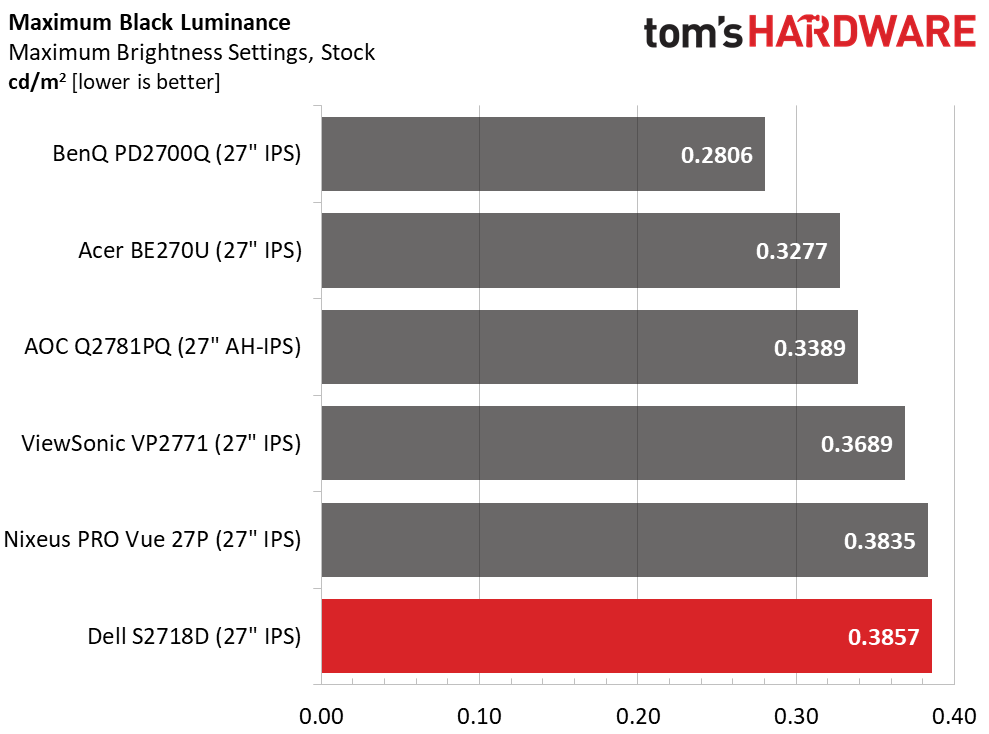
The S2718D easily exceeds its claimed 300cd/m2 spec with over 330 nits peak brightness. Technically, it’s not enough for HDR, which recommends at least 1000. But you’ll see how Dell handles that limitation in our HDR tests on page five.
The black level is disappointingly high at .3857cd/m2 resulting in a static contrast ratio of 856.8. This is merely OK for SDR and computer content, but HDR needs the monitor’s dynamic contrast feature. That’s likely why it’s locked on. And it effectively improves perceived contrast.
Uncalibrated – Minimum Backlight Level

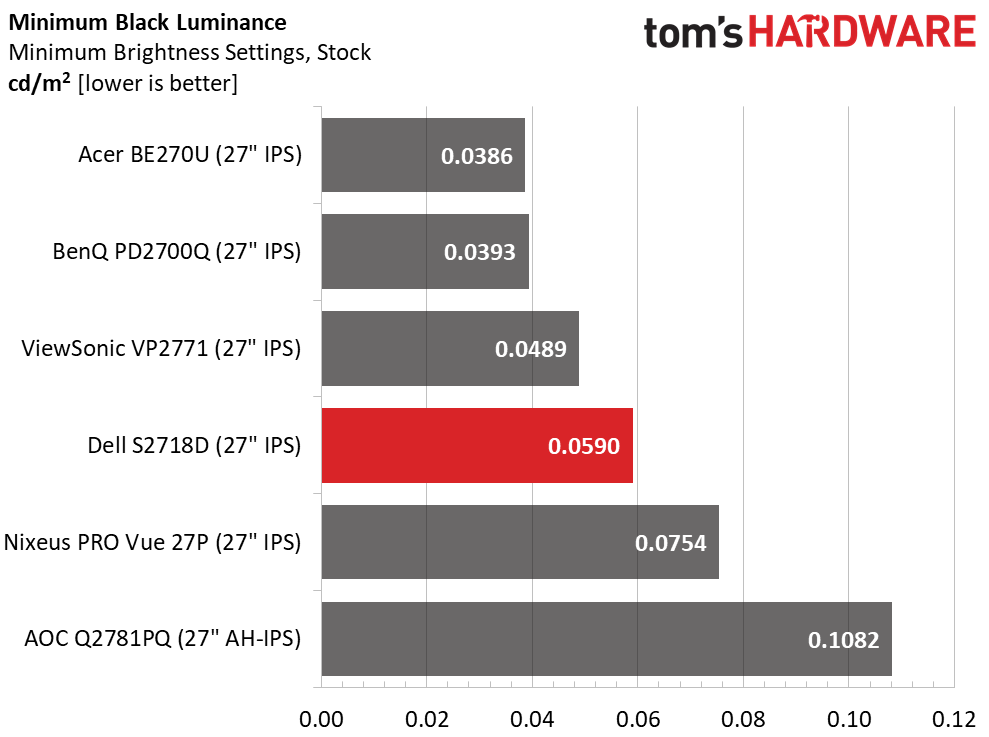
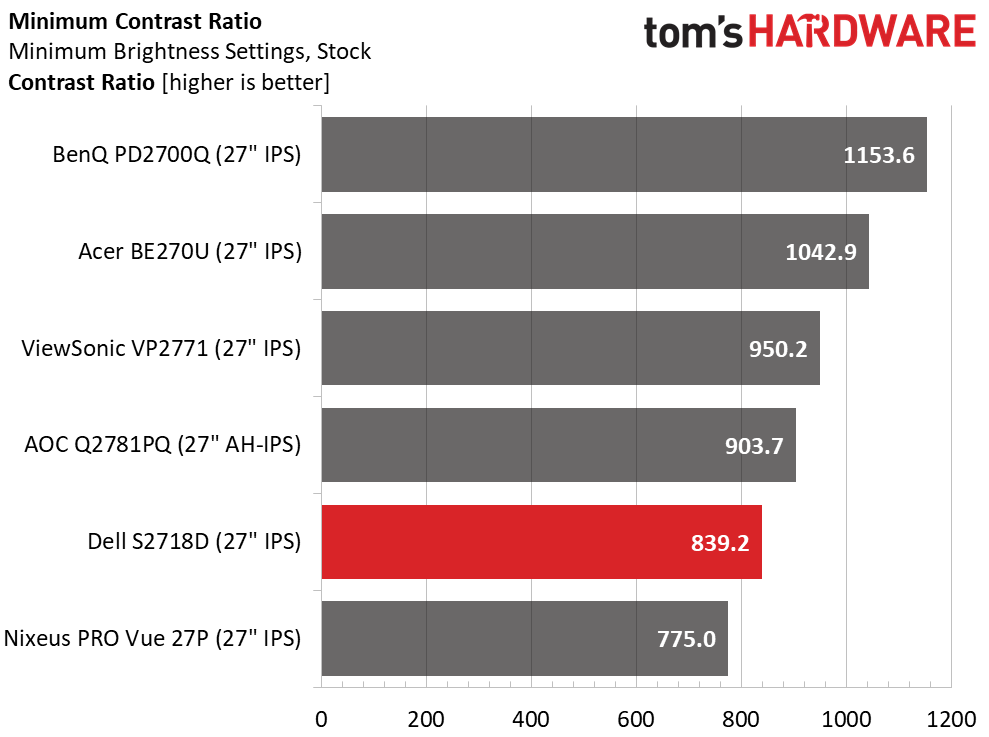
If you like to work, play, or watch in a dark room, the S2718D drops to a perfect 49.5191cd/m2 when brightness is set to zero. Black levels decrease in proportion so contrast remains consistent at 839.2:1. While the image is not the most dynamic we’ve seen, it holds up well at every output level, making it easy to find your ideal luminance point.
After Calibration to 200cd/m2

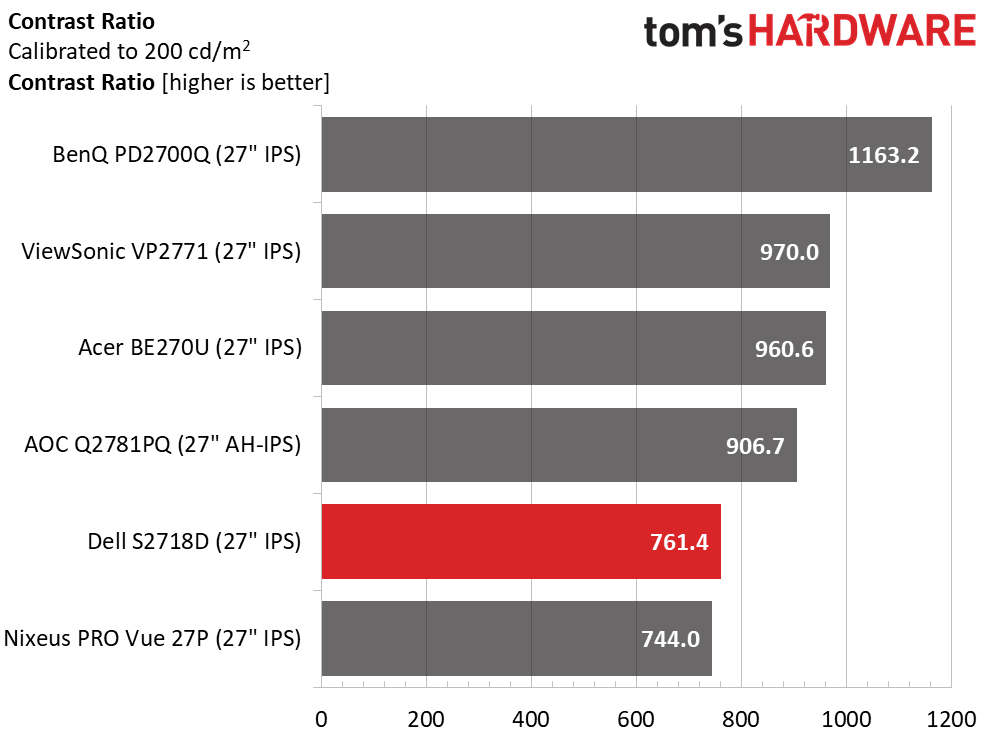
Contrast is slightly reduced after calibration to 761.4:1. Black levels are still at the back of the pack, and even though we increased the contrast slider by one click, dynamic range is still a bit below average. You can use the dynamic contrast feature in several of the fixed image presets, and it works reasonably well, but it’s grayed out in the Custom Color mode. Fortunately, it comes into play in both Movie HDR and Game HDR. These results suggest that the S2718D would benefit from the use of a VA panel. By comparison, IPS doesn’t quite have the chops for HDR.
ANSI Contrast Ratio
ANSI contrast holds steady at 771.7:1, 10 clicks above the static value. The panel is of good quality with decent uniformity, although our sample showed a few minor hotspots in the black field test. Intra-image contrast is only fair though. Again, we’d love to see a VA panel used for this application.
Get Tom's Hardware's best news and in-depth reviews, straight to your inbox.
MORE: Best Gaming Monitors
MORE: Best Professional Monitors
MORE: How We Test Monitors
MORE: How To Choose A Monitor
MORE: All Monitor Content
Current page: Brightness & Contrast
Prev Page OSD Setup & Calibration Next Page Grayscale, Gamma & Color
Christian Eberle is a Contributing Editor for Tom's Hardware US. He's a veteran reviewer of A/V equipment, specializing in monitors. Christian began his obsession with tech when he built his first PC in 1991, a 286 running DOS 3.0 at a blazing 12MHz. In 2006, he undertook training from the Imaging Science Foundation in video calibration and testing and thus started a passion for precise imaging that persists to this day. He is also a professional musician with a degree from the New England Conservatory as a classical bassoonist which he used to good effect as a performer with the West Point Army Band from 1987 to 2013. He enjoys watching movies and listening to high-end audio in his custom-built home theater and can be seen riding trails near his home on a race-ready ICE VTX recumbent trike. Christian enjoys the endless summer in Florida where he lives with his wife and Chihuahua and plays with orchestras around the state.
-
daglesj I'll take the features but ditch the stand for a standard removable with VESA and the controls built in as normal.Reply -
LionD How could 8 bit/sRGB display, with contrast 1000 and no local dimming, deliver true HDR experience? Total nonsense.Reply -
CarbonBased @GENTLEMANGREENReply
Lots of people have plenty of use for 60hz screens. stop poo-pooing products that cleary arent aimed at you. I have a rig for gaming, and sure, 60hz isn't really enough anymore. However, I take and edit photos as a hobby, so IPS, 10-bit, HDR, all very attractive features. Add that i can mate it to my photo editing laptop with a USB-C cable and were really getting somewhere. I'll be looking for this one come holiday season. -
cbliss NOT AN HDR MONITOR.. FALSE ADVERTISING.. BUYERS BEWARE!! (HDR requires 10bit panel, this is 8bit.. It also lacks any form of local dimming). Bogus product for hdr, otherwise simply an overpriced QHD monitor).Reply -
CarbonBased Fair enough, I didnt realize that it was 8 instead of 10 bit. But I will stand by my point that 60Hz is fine for many, if not most, computer users, even if they are gamers. the market for high refresh rates is specifically gamer-centric. Dissing product thats arent built to gamer spec because you are a gamer does not lend one to being an unbiased source of opinion.Reply -
Scott____67 i like to wall mount my monitor anyways so the stand is non existent and in a condo it keeps areas and desk spaces clear plus having a little height with a downward pitch is perfect for the lean back in the chair gamer that i amReply -
alextheblue Reply
Agreed. A 60hz monitor isn't great for gaming anymore, so for my personal needs and budget I'm better off with a halfway decent TN panel with high refresh rate, wide freesync range, and low input lag. That might change in the future, as advanced displays come down in price. But today that's what best fits my needs.19973045 said:Fair enough, I didnt realize that it was 8 instead of 10 bit. But I will stand by my point that 60Hz is fine for many, if not most, computer users, even if they are gamers. the market for high refresh rates is specifically gamer-centric. Dissing product thats arent built to gamer spec because you are a gamer does not lend one to being an unbiased source of opinion.
But as you said most non-gaming applications don't need high refresh rates. Users who don't game will typically favor resolution, contrast, brightness, viewing angle, and color reproduction over refresh rate and input latency. If you have a sub-$300 budget like I do you often end up with a display that either favors gaming performance and features, or image quality and advanced colorspaces. Just because you favor a high-refresh gaming monitor doesn't mean you can't recognize uses for a non-gaming display.
Granted if you spend enough money you can get a display that doesn't compromise much and is fairly good at everything. Way out of my price range at this point, though. -
alextheblue ReplyTo see HDR content, you’ll need a compatible player or computer with an HDMI 2.0/HDCP 2.2 output. The latest Ultra HD Blu-ray players feature this interface. You can also connect with the right video card. Fortunately, there are quite a few choices. On the Nvidia side is the GTX 950 up to the Titan X (Maxwell), or the GTX 1050 to Titan X (Pascal). AMD users can employ an R9 390X or RX 460, 470, or 480.
I thought anything with Polaris would support HDR10, such as Radeon 540/550 (Polaris 12). Maybe I'm misremembering. Also, on PC you have to have to use HDR10 compatible playback software to benefit.
On the console side of things, Xbox One S has supported Ultra HD (4K HDR10) BDs for some time. If I was looking for a dedicated box, it's a good choice even if you don't play console games. It's not much more than a decent dedicated 4K HDR10 player, and it has better support for apps. You can add a Kinect if you want voice control. If you don't use physical discs but want a dedicated box for 4K HDR streams, then I'd recommend a Roku Premiere+ or Ultra.
